You are reading the older HTML site
Positive Feedback ISSUE
november/december 2007
Impressions: The Teac Esoteric DV-60 Universal Player Part One
- Stereo SACD/DVD-A/CD/CD-R Playback
by David W. Robinson
[All photographs and image processing by Robinson, unless otherwise noted.]
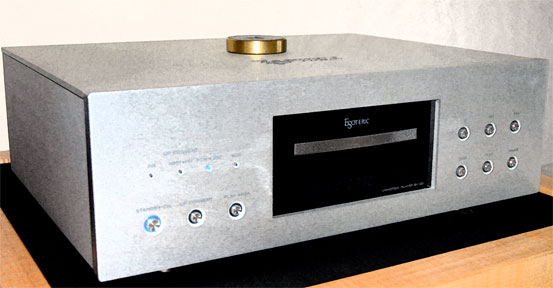
A fresco of the Teac Esoteric DV-60, sporting a Walker Audio Valid Point Disc for enhanced vibration control, atop a Critical Mass Systems Grandmaster Black isolation stand
A world without standards
It used to be easier.
If you wanted good music, you cued up an LP.
Open reels were for the truly ambitious and ambidextrous, willing to live with the demands of technique and a limited catalog (greatly enhanced by passionate dubbing, bootlegs, and the occasional live recording) in order to gain performance. Not for the faint of heart, though, which left the typical consumer out of the mix. The mass market developed alternatives over time: audio cassettes coaxed a fairly remarkable amount of sound out of a piddly tape width and 1 7/8 IPS tape speed …still pretty amazing, when you think about it.
Then came digital. CD started slowly enough, back in 1982-83, but once the little aluminum devils gathered momentum, they swept most of the alternatives before them. As the major labels became confident in the market acceptance of CDs, they began to demote—and then discontinue—the LP, followed in time by the audio cassette. This was done regardless of the resistance of audiophiles, who, truth to tell, don't matter to the major labels. ("How many divisions does the Pope have?") The militant niche was ignored, and a format change was enforced. While cassettes have mainly gone the way of the flesh, LPs are doing well enough as a "specialty product," and very well among those willing to scavenge the remains of several decades' worth of vinyl domination—myself included.
Despite other digital formats since deprecated (remember DAT, MDs and DCCs?) CDs became the de facto standard by the early to middle '90s. Let the weirdo audiophiles, vinyl junkies and analog addicts mope; now we have a real standard in the marketplace. Right?
Well, maybe not.
Before the roiling waters of audio could calm down, the late '90s brought in new trial standards. Higher resolution was attempted via DSD its SACD optical format; not to be outdone, high-resolution PCM led to the competing DVD-A format. Which meant that now the optical digital domain was fragmented into a confusing series of sub-domains and warring specifications: SACD. DVD-A. CD/CD-R/CD-RW. Dual-Disc. MP3. In a world with so many optical alternatives (not to mention the video realm of DVD, VCD and SVCD, with Blu-Ray and HD-DVD as the next generation of dueling disagreements), it's tough for an audiophile to figure out which medium/media to invest in. Worse yet, for various reasons—pride, power, avarice, disputes with artists, licensing hassles, and clueless bean-counting—the major labels have usually not been willing to settle their differences for the good of the audio lover.
And that, sports fans, is an understatement.
The result for you and me was that some catalogs could be found only on SACD (which, usually being hybrid, meant that consumers always had a city of refuge in the CD layer), while others appeared only on DVD-A. Unfortunately, most titles appeared on neither, and stayed comfortably on CD. Ironically, due to the ubiquitous nature of PC-based PCM tools, CDs are likely to be largely displaced over time by downloadable formats played by via solid state devices. LP and SACD lovers may chuckle nastily at this point.
So …what to do with the multiplicity of formats?
Enter the universal player.
In theory, a universal playback device slices through the Gordian knot of confusion by playing as close to all of the available formats as possible. In fine audio, this is to be done with the best possible quality, but the variety of engineering requirements mandated by differing standards make doing so an exercise in trade-offs and compromise—or in cost. Alternatives exist at various price points, ranging from the engaging and incredibly affordable-to-the-general-public Oppo line to the formidable, but expensive Linn Unidisk 1.1. I own the Unidisk 1.1, and love its excellent overall performance. Despite my concerns about the compromises inherent in "universal" anything, Linn's achievement in the Unidisk 1.1 made me more optimistic that superior performance is attainable in the category. And its quality has spurred me to follow universal players ever since the optical formats scattered to the winds.
But what about other alternatives?
The Teac Esoteric DV-60
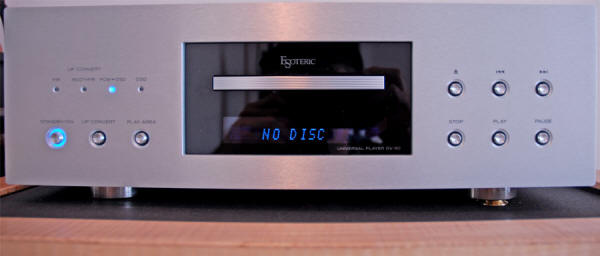
Among the manufacturers that I was monitoring was Teac, specifically their Esoteric line of SACD and universal players. Teac's Esoteric DV-60 universal player caught my eye, due to the fact that it had a native DSD playback system, as well as a PCM à DSD conversion option. The Esoteric line also has several universal players which convert DSD to PCM for playback, but these don't interest me nearly as much. (I still have yet to find a DSD à PCM playback platform that doesn't …well …sound like "PCM" to my ears, even in the reference-grade examples I've evaluated. For the uninitiated, wondering about that comment, NB: there's always a certain glare, an edge, a bit of forwardness, a touch of the ol' Technicolor lurking in DSD à PCM presentation. Given the virtues of DSD, why harm the signal by tossing it into decimation? I'll stick with steak; you can have hamburger if you like. But why would you?)
My good friend Doctor Sardonicus, he of the bazooka prose and the never-a-dull-moment pungent wit has long been a fan of Teac's build quality. And I have been curious about hearing their work in my own listening room for a long time. Perhaps it was time to reach out and touch someone, eh?
Providentially, I was able to contact the Esoteric division at Teac and was able to arrange a review sample of the DV-60 for me to evaluate. Since the Teac Esoteric line has a deserved reputation for producing products built to extremely high standards, I was intrigued to see how their latest-generation universal player would stack up in my listening room.
General description and specifications
Right out of the box-within-a-box, the DV-60 has obvious strong curb appeal. The review unit was finished in an attractive brushed aluminum, with a clean and logical layout of controls and display. Hefting the unit out of the box is definitely a two-handed proposition, confirming the presence of lots of metal. No surprise here; the DV-60 tilts the balance beam at nearly 31 pounds. The remote control is likewise rendered in a matching aluminum and leather case, with a satisfying heft and a pile of handy function controls.
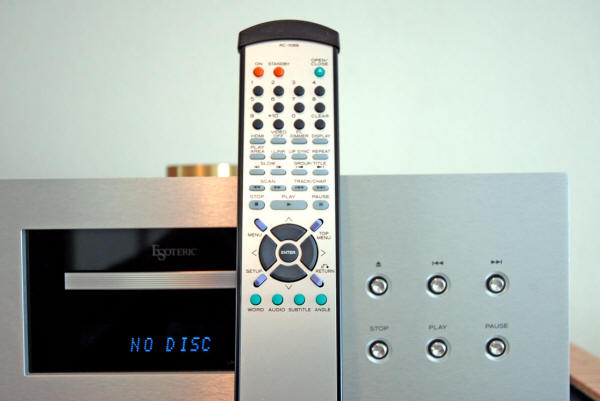
The DV-60 remote control: hefty and functional
The capabilities and specifications for the review unit were lengthy. As befits a universal player, the DV-60 plays single layer, dual layer, and hybrid SACDs, all varieties of DVD-As, CDs/CD-Rs/CD-RWs (with the usual cautions about the quality of the CD-R/RW discs/recordings, and the appropriate reminder that all such discs must be finalized by their authoring software before use), DVDs, DVD-R, DVD-RW (no mention of DVD+R or +RW), and even that odd duck VCD (video CD). No CD-ROMs or DVD-ROMs of course.
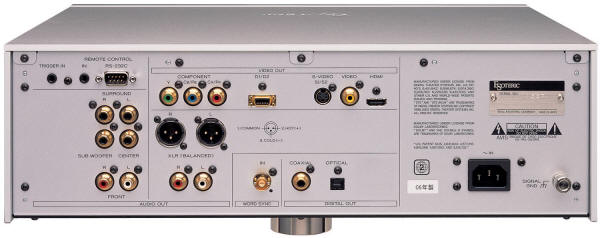
Rear view of the Teac Esoteric DV-60, showing its array of I/O ports (image courtesy of Teac Esoteric)
Maybe it's my (too many) years in information technology, but I spend a lot of time looking at the ports on any audio device that I evaluate. Sometimes you're disappointed at what's there—and what isn't—but that wasn't true this time. The I/O set on the back of the DV-60 is quite respectable. Outputs include a complete set of six unbalanced (five plus a subwoofer) for analog surround, a pair of unbalanced for standard stereo, and a balanced stereo pair. Digital audio out was more constrained, consisting of only a single S/PDIF and a single TOSLINK. (Does anybody really use TOSLINK? Does anybody really care?) There is no output for AES/EBU, BNC, or ST optical fiber; on the other hand, there is a BNC input for use with an external word clock, which Teac also builds.
Video output includes the now-mandatory HDMI (version 1.1, which means that it will not output DSD; for that you need at least HDMI 1.2a, plus something at the other end that can decode it), a single set of Component RCAs, a D1/D2 digital video port, one S-Video port, and a Composite video port. Teac's choice of D1/D2 is somewhat obscure to me, as I would have preferred to see either DVI or a video BNC set, but there are some video projectors that use D1/D2. I assume that this is what Teac was aiming at here, though this choice is obscure to me. Other I/O includes input jacks for remote control, plus an RS-232C DB-9 for custom work/programming.
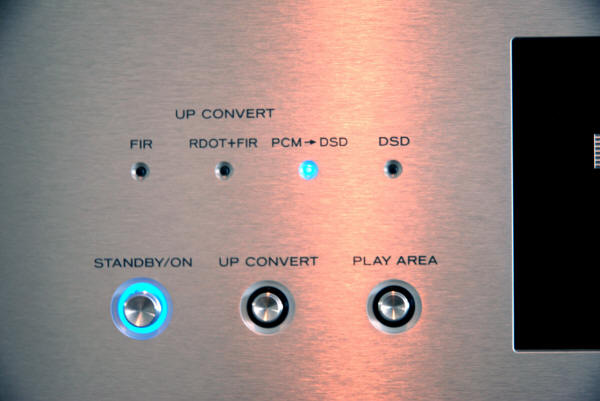
DV-60 left side controls
The front of the unit has power and digital conversion options plus SACD/DVD-A Play Area options to the left, and the usual playback controls to the right. "Play area" allows the selection of an SACD layer (SACD or CD on a hybrid disc), or allows you to choose which resolution folder to access in DVD-A—very handy, that. The control of particular interest to me was the "Up Convert" button. This allows the user to select one of three choices for PCM playback: either FIR (Finite Impulse Response), RDOT (Teac's proprietary "Refined Digital Output Technology")+FIR (a digital coupling of FIR with Teac's RDOT), or PCM à DSD, which undecimates the signal to DSD, then passes it through the DSD converter (Cirrus Logic CS4398 chipset) . The DSD setting is for SACDs only. According to Teac, the CS4398 chipset is used in a dual mono configuration for stereo as a separate and distinct board implementation from the multi-channel circuits (which also use the CS4398 chipset).
The FIR setting is Teac Esoteric's implementation of that filter, with 8x up conversion. Teac claims a nominal 24-bit result from the process, with effective sampling rates ranging from 352kHz (44.1kHz x 8) to 1536kHz (192kHz x 8). (By the way, Teac specs list their sampling rates (Fs) for various PCM formats in "Hz," not in "kHz," for reasons that are not clear to me. I checked with Teac's Esoteric division, and it turns out that this a typo in the otherwise excellent documentation.) RDOT+FIR, a process in which FIR is handed off to RDOT in the digital domain for further processing, produces a claimed 24-bit/32x result. Teac Esoteric states that FIR+RDOT provides improvement to playback performance; I'll share my impressions of the sonic results later in this essay.
I was glad (which is an understatement) to see the PCM à DSD option for playback of PCM discs, since this is the mode that my reference EMM Labs gear has provided for quite some time now. Sending PCM to DSD (instead of the other way around) has always sounded better to me—much better—endless arguments about rising ultrasonic noise floors in DSD to the contrary. So I was looking forward to giving the DV-60 a ride around the block.
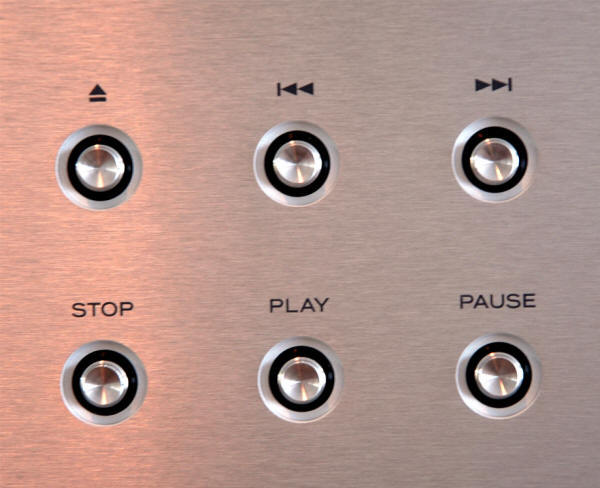
The usual suspects over on the right side of the tray…
Placement, path, and operation
I placed the DV-60 on the top shelf of my Critical Mass Systems Grandmaster Black stand. This represents some of the very finest isolation that I've found, and would assure best isolation of the component while I listened. A single Walker Audio Valid Point tuning disc was placed on the DV-60 for resonance control. Power cabling was supplied by the JENA Labs 916, which in turn was plugged into the exceptional Walker Audio Velocitor power line enhancer. Output from the DV-60 was via a pair of the JENA Labs Symphony XLR. This ran to my EMM Labs DCC2 preamp/DSD DAC, and from there to the LAMM M1.2 Reference monoblocks by means of JENA Labs Duo Shielded XLRs. Silent Source speaker cables handled the mid-range/treble feed, JENA Labs Symphony cables the bass feed, on the "final mile" to the Nova Rendition IIs.
I gave the DV-60 the usual sort of run-out: a day of simple warm-up, followed by several weeks' worth of play, without listening critically. I wanted to be sure that the unit was tolerably warm and stable before evaluating what I was hearing.
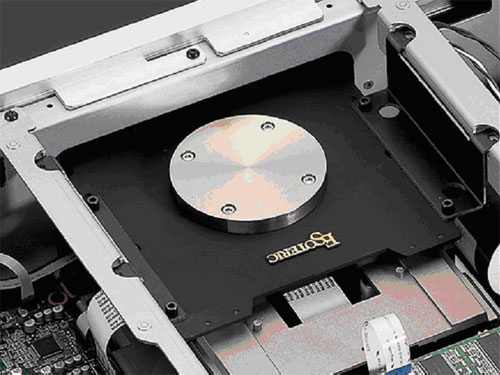
Interior view of the DV-60's sturdy internal drive (image courtesy of Teac Esoteric).
I must say that I quickly fell in love with the ergonomics of the DV-60. Unlike some (all too many) of the SACD players currently available, the operation of the tray was consistently smooth, quick, and flawless. I love my EMM Labs CDSD SE transport, but the action of the EMM Labs was not in the same class as the new Esoteric drive of the DV-60. Readers should take note, however: this new drive is definitely not Teac's very highly regarded VRDS or VRDS-NEO. Teac Esoteric has obviously developed a new drive based upon concepts from the VRDS-NEO, built to a lower price point. Teac Esoteric lists this as a "proprietary transport and drive mechanism" in its documentation and marketing sheets; it is certainly an excellent drive, but it is definitely not the VRDS-NEO. In fact, this new disc transport is known as VOSP ("Vertically aligned Optical Stability Platform"), and uses Esoteric's P-03 series optical sled assembly.
I am well acquainted with the VRDS and VRDS-NEO drives; where those are all steel, or a combination of steel and aluminum in construction, the DV-60's drive has a plastic tray with a metal interior frame (see image above). Both drives are quiet in operation. In fact, I recently used my Cen-Tech meter (fast response, C weighted) to measure the operational sound level of an Esoteric UX-1 VRDS drive at a persistent 54dB-56dB at a distance of ½", centered on the closed tray. The Esoteric DV-60 measured just slightly louder, at a persistent 56dB-58dB at the same place and distance on the tray. The DV-60 is somewhat noisier in loading than a VRDS or VRDS-NEO unit, but I did not judge it to be unacceptably so. Having said all this, I should state that my all-time favorite for elegance in front-loading optical disk engines remains the Linn CD-12: all milled metal construction, silky action, and extraordinarily quiet; only the VRDS/VRDS-NEO come close to that standard, in my experience. I lament the passing of the CD-12, and regret that Linn never produced an "SACD-12" along the same lines.
The remote control is another fine piece of work, as I mentioned above. Not only is it hefty, being well constructed of aluminum and leather in a finish like the unit it commands, but its layout is clear and the action of its buttons quite positive and reliable. At no point did I have any problems with the remote – it always worked, and the DV-60 always responded properly to its signals. And no, that is not always the case. Some remote controls seem to be mainly constructed to be thrown at a wall or out a window by their owners, in a fit of frustrated rage at their clumsy operation, tiny buttons, or cheesy plastic construction. This remote control will keep you from being hauled off by the local gendarmes.
I have used the DV-60 since the early spring of 2007; during that time, the reliability of the DV-60 proved to be exceptional. There were no glitches or vapor locks, requiring me to power cycle the player. I didn't have a single problem with failed TOC read-ups, whether on SACD or DVD-A, nor did I find a CD-R that wouldn't come up. This included several SACDs that had been problematic on the Linn Unidisk 1.1 and the EMM Labs CDSD SE. To date, the DV-60 has been the most stable and reliable multi-format player that I have ever reviewed – and that's no minor point in my book. I wish that all digital playback systems were as trouble-free as my time with the Teac Esoteric DV-60 has been. (The DV-60 has a standard two year parts/labor warranty, extended to three years if you send in your registration card, but I'm not sure you need to worry too much about it. The thing just works.)
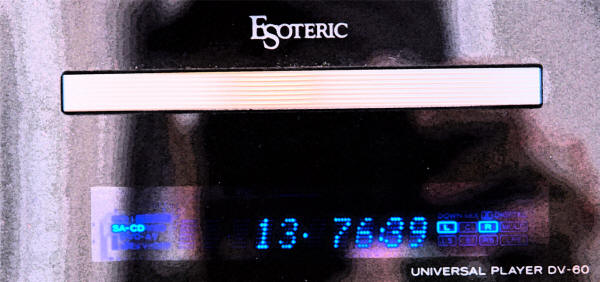
Enough! How's it sound?!
Well, in many ways I really like the Esoteric DV-60. It does a number of things very well…some of them better than any multi-format player that I've heard. Remember that the very idea of a "universal player" of necessity involves a series of compromises, and that it's no shame at all for such components to have limitations in at least some sonic parameters. In fact, any multi-format player that can do reasonably well in most categories, while excelling here and there, has already earned my respect, at the least. You should also keep in mind the MSRP $5,600 price point of the DV-60; while not a "budget player," it's certainly possible to spend a lot more than this.
Keeping this firmly in mind (please!), I'd characterize the DV-60's sonic profile in my listening room as follows:
-
The tonal balance is slightly warmish to my ear, and more analog-like than other Teac Esoteric models that I've heard. The Cirrus Logic chipset for DSD mode or PCM à DSD doesn't have the same PCM feel that other designs have. There is no obvious grain or astringency that is the kiss of death to my interest. Detail on SACDs is rendered clearly, though, and without excessive romance. As an example of a disc that I use for evaluating tonality and timbre, check out Stockfisch's terrific recording of Johan Schenk, Christiaen Herwich, and Philippus Hacquart performing 17th century Dutch compositions for the viola da gamba, The Spirit of Gambo: the Galaxy Recordings (SFR 357.4042.2). The entire SACD is a treat, without musical stereotypes or over-performed standards, and I think that the DV-60 did very credibly in presenting the palette of the recording. Likewise, the well-recorded soundtrack for A Beautiful Mind (Decca SACD 440 018 139-2) is tonally rich and warm without being too much sugar in the tea.
-
I mark the imaging to very good, though it's definitely not as precise in placement as the EMM Labs CDSD SE/DCC2 SE tandem, which remains my reference for SACD stereo playback. (Naturally, there is a noticeable price differential here; the EMM Labs combination will run you a cool MSRP of $21,900, as opposed to the $5600 of the Teac Esoteric DV-60.) On the other hand, the DV-60 does give my long-time friend the Linn Unidisk 1.1 (MSRP $11,000) a run for its money in this regard. One of my favorite Top Music SACDs, Joe Weed and the Vultures (SACD 1028), lays out very well with the DV-60. The musicians are well delineated in space, and satisfying to listen to. In fact, the entire family of Top Music SACDs (and I have most of them) are excellent choices for those wishing to evaluate imaging in their listening rooms.
-
Soundstaging, that ability to present a more or less wide/deep/high presentation of a stereo field, is well done with the DV-60. An excellent recording (and a remarkable collection of little-known compositions) for evaluating this quality is Hyperion's splendid Moon, sun & all things: Baroque Music from Latin America (SACDA67524). Jeffrey Skidmore and Ex Cathedra are captured in a marvelously dimensional performance; any fine audio system worth its salt will give you a sense that your listening room has melted away, and that you are sitting in a cathedral space. The opening song "Hanacpachap cussicuinin," composed in Lima, Peru, in 1631, is simply breathtaking as an example of what's possible in depth and height. The DV-60 negotiated this test in excellent form, though again without that last word in layering, holographic depth, and the roundness of form which the EMM Labs CDSD SE/DCC2 SE is truly the master of.
-
In the area of dynamics, the DV-60 does very well indeed. For a modern example of large scale dynamics, I enjoyed the LSO SACD of Sir Colin Davis conducting Sibelius Kullervo (SACD LSO0574) immensely on the DV-60. Kullervo is a composition that I have loved from the first time I heard it back in the '80s, and I have listened to it many times on vinyl, CD and SACD. Ugly reproduction would be immediately known to me, especially any sense of the loss of resolution at the source end; I am happy to say that the DV-60 was able to pass this test. The movement from pianissimo to fff was handled very well, including the choral passages that can congest on lesser sources. Likewise, the sudden smaller scale dynamics and plucking of Sarah O'Brien's delightful Harp Recital, an SACD from Audite (92.561) that deserves a wider audience. Check out the opening of Caplet's Deux Divertissements for an example of what I mean. For a fine (and refreshingly different) example of solo cello dynamics and deeply felt interpretation, Gavriel Lipkind's performance of Bach's Six Suites for Cello Solo (Edel Classics/Lipkind Productions) is very satisfying. At no point did the DV-60 get in the way of that experience; in fact, dynamics (both macro and micro for those who distinguish such things) were a strong suit of this component. The DV-60 had a greater verve than the Unidisk 1.1, though it didn't have the same kind of dynamic punch that the EMM Labs CDSD SE/DCC2 SE have.
-
Finally, in that all-important category of transparency – the sonic quality that I have come to prize as the foundation of all others – the DV-60 is credible, certainly giving the Unidisk 1.1 some competition as a universal player that can minimize veiling when properly set up. I must emphasize that last phrase because, in my experience, improperly set up digital sources can be distinctly disappointing. The DV-60, like all of its digital brethren, responds to proper sonic isolation, power conditioning, and cabling. The JENA Labs power cable helped quite a bit; I only wish that I had another of their superlative Power One power cables, though. I suspect that it would have hoisted the DV-60 to another level in the areas of both harmonic richness and transparency.
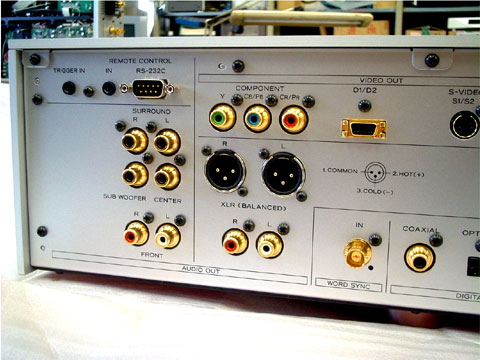
A close-up rear view of the Esoteric DV-60 (image courtesy of Teac)
The above notes apply to SACD primarily, and DVD-A secondarily. Frankly, I liked the DV-60's playback of DVD-As very well; I ended up liking the sound of that format on this unit quite a lot. Those who can't afford a Unidisk 1.1 would find that they aren't giving up much at all with the Esoteric DV-60.
Regular CD playback was simply excellent. After experimentation, I found myself divided between playing Red Book in FIR+RDOT mode (punchier, with a greater sense of extension) and PCM à DSD mode (smoother, silkier, more analog-like). I think your mileage will vary, depending on what floats your boat, and the kind of music that you listen to. The flexibility of the DV-60 gives you the ability to fine tune playback modes to source material, which is an essential quality in a universal player. Those of you with large CD collections will find that you won't have to sacrifice superior stereo CD playback to get SACD, DVD-A and DVD video—surround sound and all.
By the way, my notes here also apply to CD-Rs. I didn't find a CD-R that caused any problem at all for the DV-60. Playback quality follows what I said about FIR+RDOT vs. DSD, immediately above.
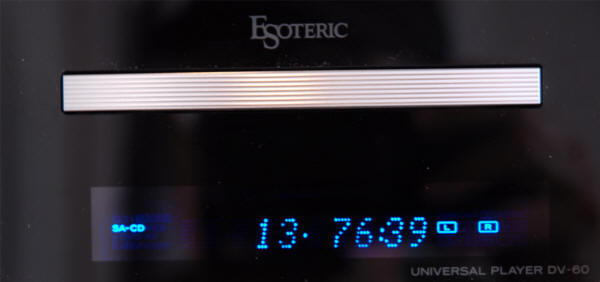
Some conclusions
So, how to summarize the Teac Esoteric DV-60?
Well, I believe that it is the first universal player I've heard in my listening room that's given the Linn Unidisk 1.1 a sonic run for its money in stereo mode—and that at about half the price. The audio playback is very good to excellent in all major categories for SACDs, DVD-As, CDs and CD-Rs. In SACD playback the DV-60 excels in dynamics, and is a very good performer in soundstaging and imaging. I am encouraged by Teac's inclusion of the Cirrus Logic 4398 chipset, which handles PCM à DSD and native DSD playback in a manner that is noticeably improved over earlier PCM-based models that I have heard from this manufacturer. The FIR and FIR+RDOT options for PCM playback make the DV-60 a fine CD playback system, as well; the FIR+RDOT was especially good for the little silver devils in my opinion. The flexibility and intelligence of Teac's new playback options make the DV-60 an attractive option.
And for the ergonomics of the controls, the quality and reliability of their playback drive and the rock-solid operation of the DV-60, as well as its built-like-a-beautiful-tank looks, the folks at Teac Esoteric deserve some serious kudos. Too many high-end digital sources have proven to be less than stellar performers, causing serious grief to their owners over time—and some of them are ugly to look at, and ugly to use, to boot. At the very least, a person who spends at this level deserves some degree of confidence that their player will not be locking up or conking out when switching from SACDs to DVD-As to DVDs; my time with the DV-60 was completely void of nonsense like that. In fact, the ergonomics of the DV-60 were the best I've seen for digital playback since the Linn CD-12, which remains my reference for beauty, elegance, and ergonomic brilliance.
The new Teac Esoteric proprietary transport isn't the VRDS-NEO, unfortunately …but then again, it doesn't cost $13,000. Would I like to see Teac combine the digital playback options of the DV-60 with the VRDS-NEO drive? Of course I would. That would be a combination worth serious consideration in that price category. (My dream configuration: a Teac VRDS-NEO drive hooked to an EMM Labs chipset …dream on!) But I'm quite sure that we'd be looking at a price more than twice that of the DV-60.
The folks at Teac have built a very fine universal player at an important price point, have thoughtfully included multi-channel output, and have included 14-bit video and HDMI for those of us who have moved to 1080p video. (The only drawback here is that the HDMI spec supported on the DV-60 is the already-aging 1.1—Teac needs to support HDMI 1.3 as soon as possible. Perhaps in 2008?) I regret that my schedule wouldn't allow me to review the DVD video portion of the DV-60. I suspect that its video performance will give the Linn Unidisk 1.1 really serious competition. Perhaps in the future I'll be able to re-visit and evaluate the Teac Esoteric line purely for its DVD and Blu-Ray (1080p) performance.
[Update: The Teac Esoteric division has extended the loan of the DV-60 so that I can evaluate its video performance. I should be able to report on this by February of 2008.]
I've been thinking carefully about the DV-60 for quite a while now; this review project took quite a lot of time, and this essay took quite a bit longer. Overall, I have to say that I think that it is the best universal player that I have heard to date, and that at a substantial savings over the Linn Unidisk 1.1. Set it up correctly—give it synergistic support components—and the DV-60 will give you years of excellent audio and rock-stable performance. I shall be very sad to see this fine accomplishment leave my listening room, believe me.
I am therefore giving the Teac Esoteric DV-60 a "Ye Olde Editor's Very Highly Recommended!", and will be including it in my list of 2007 Brutus Awards.
Those looking for an extraordinary universal player: do not miss this one!
